The Russian military is conducting a series of exercises designed to test and showcase its ability to mount large-scale joint operations at the very eastern edge of the Russian Arctic, more than 7,000 kilometres from its main base near the border with Norway.
The exercises are part of the much larger Vostok 2018 (East 2018) war games involving nearly 300,000 servicemen of Russia’s Eastern and Central military districts that cover nearly 14 million square kilometres, an area larger than all of Canada.
Vostok 2018 war games involve ground forces, units of the Northern Fleet, Russia’s elite Airborne Troops, long-range and military transport aviation of its Aerospace Forces, as well as thousands of Chinese troops.
On Tuesday, Russian marines and elements of the Arctic motorized rifle brigade of the Northern Fleet conducted a mock amphibious landing assault on the coast of the Chukchi Sea near Cape Vankarem, followed up the next day by exercises to search and destroy enemy commando groups in Chukotka, according to Russian officials.
To get to Chukotka the Russian warships had to sail more than 4,000 nautical miles (7,408 km) over the Northern Sea Route from their base in the Kola Peninsula in northwestern Russia.
Largest war games since 1981
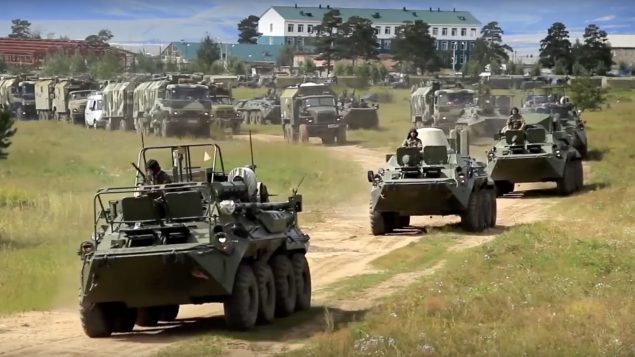
In this frame grab provided by Russian Defense Ministry Press Service on Tuesday, Sept. 11, 2018, Russian armored personnel carriers roll during the military exercises in the Chita region, Eastern Siberia, during the Vostok 2018 exercises in Russia. (Russian Defense Ministry Press Service pool photo via AP)
Rob Huebert, an associate professor in the Department of Political Science at the University of Calgary and a senior research fellow with the Centre for Military and Strategic Studies, said Vostok 2018 is the largest military exercise held by Russian forces since the military drills held by the Soviet Union in early 1980s at the height of the Cold War.
“They’re doing it for at least three reasons,” Huebert said. “The first, of course, the Russians are a hegemon in the Arctic region, they are the most powerful state there, and in terms of sending a message to the general international system, showcasing just how powerful they are, this is the place to do it. That’s where they do it better than probably any other country.”
The Arctic component of Vostok 2018 war games also sends a message to Scandinavian countries, particularly Sweden and Finland, warning them against abandoning their traditional neutrality and joining NATO, Huebert added.
“The third thing is that they also have to be practicing to improve their capabilities in that region because it continues to be the centre of both their regional development – oil and gas, and shipping – as well as at the centre of their geopolitical doctrine and that of course is their nuclear deterrent,” Huebert said.
Message to the West
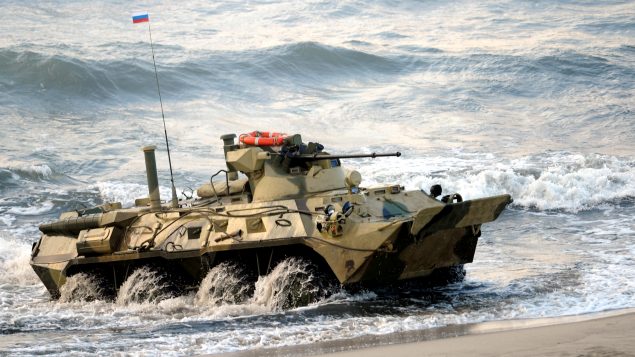
Russian troops practiced troop landings in Chukotka, earlier this week. In this picture, taken in 2013, a BTR-82A amphibious armoured personnel carrier, such as those used during training this week, lands on shore during an exercise in Kaliningrad. (Alexey Druzhinin/AFP/Getty Images)
The amphibious landing on the coast of Chukotka, a historic first according to Russian officials, is also meant to send a message to the Baltic states, Huebert said.
“It’s clearly meant as an intimidation factor against the Baltic states,” Huebert said. “Showing that if they were to do an assault on that region, they’d be doing it both from the sea and from the land, which makes it that much more complicated for any effort from NATO to respond.”
Katarzyna Zysk, professor of international relations and director of research at the Norwegian Institute for Defence Studies, said over the last decades the Russian military has emphasized joint operations and strategic mobility, constantly improving its ability to move various ships and units from one theatre of naval operations to another.
Climate change and the increasingly open Northern Sea Route along Russia’s Arctic coastline from the Barents Sea in the west to the Bering Sea in the east has allowed Russia’s Northern Fleet to extend its area of surface ship operations from its traditional base on the Kola Peninsula, Zysk said.
Since 2012, Northern Fleet warships have regularly sailed along the Northern Sea Route all the way up the New Siberian Islands and other islands in the western and central parts of the Russian Arctic, Zysk said.
“But now they are moving towards using the whole passage to get to the Pacific Fleet, which is a very interesting development,” Zysk said. “It’s something that we had wondered whether this would happen and it’s actually happening.”
In addition, Russia has invested significant resources to build the world’s largest fleet of civilian nuclear-powered icebreakers and for the first time since the end of Cold War has begun construction of diesel-electric icebreakers specifically for the navy to allow its warships greater access to the Arctic, Zysk said.
Protecting Russia’s economic future
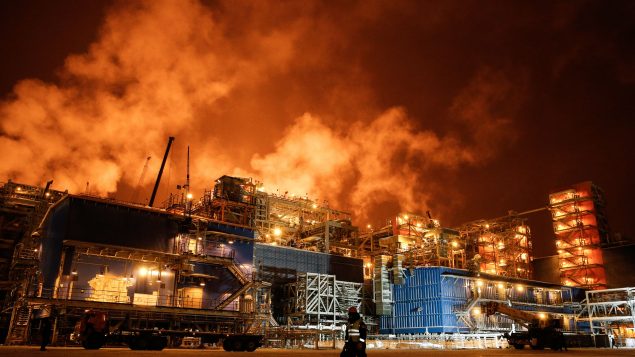
TOPSHOT – A view taken on December 7, 2017 shows the Yamal LNG plant in the port of Sabetta on the Kara Sea shore line on the Yamal Peninsula in the Arctic circle. (Maxim Zmeyev/AFP/Getty Images)
Russian military exercises in general and in the Arctic in particular have grown in scope and complexity over the last decade, said Adam Lajeunesse, the Irving Shipbuilding Chair in Canadian Arctic Marine Security Policy with the Mulroney Institute of Government at St. Francis Xavier University in Nova Scotia.
“I think the big change and the reason for the increasing size and complexity is the increased activity in the North and the increased international presence in the North,” Lajeunesse said. “Today the Russian Arctic is seeing unparalleled growth – new oil and gas activity, tens of billions of dollars with planning for hundreds of billions of dollars to be invested across the Russian Arctic.”
The Russian Arctic is an existential requirement for the state, Lajeunesse said.
“The development of that region is absolutely required for the Putin government to achieve many of the aims it set out,” Lajeunesse added. “The Arctic is probably the future of Russian oil and gas production and oil and gas production is a requirement for the continued existence of the Russian state as it exists today.”
And just like Canada, with climate change the Russians are finding themselves with a very large and a very exposed coast with increasing economic and shipping activity in the Arctic and have to train to respond to various incidents.
“Defending that region, responding in an event of an oil spill, a grounded ship, of any potentially unforeseen eventualities is very important for Russia, and they do need to do it on a larger scale than we do because the activity is on such a larger scale,” Lajeunesse said.
No threat for Canada
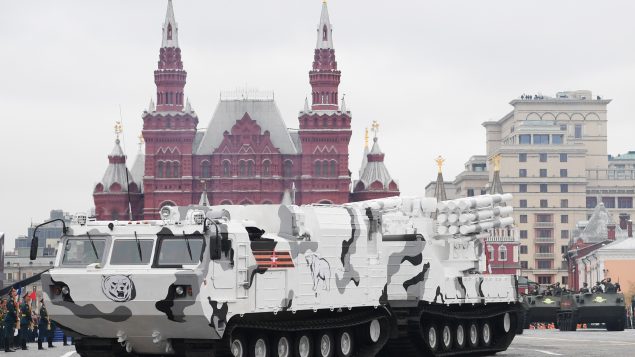
A Pantsir-SA air defense system Arctic edition rides through Red Square during the Victory Day military parade in Moscow on May 9, 2017. (Natalia Kolesnikova/AFP/Getty Images)
Still Lajeunesse says he doesn’t believe that these exercises pose a direct threat to Canada.
“I think it’s easy to make a frightening jump from the Russian Arctic to the Canadian Arctic and to say we have a hostile nation that is practicing Arctic amphibious landings but there is really no conceivable scenario where the Russian army invades the Canadian Arctic,” Lajeunesse said.
“In the event of a conflict with Russia, I think, perhaps, the last place on the planet the Russians would look to invade would be the Canadian Arctic. There is simply nothing of strategic value there and nothing for the Russian army to do once they get there.”
NATO’s response is coming
Lajeunesse said he agrees with Huebert’s assessment that the increased Russian capabilities illustrated by Vostok 2018 exercises pose more of a threat to Russia’s Nordic neighbours, adding that NATO planners have worried for decades about the prospects of an amphibious assault on Norway.
“I think any time the Russian military practices amphibious operations along a rough terrain, that is potentially a practice for landing in northern Norway,” Lajeunesse said.
In fact, NATO will kick off in October its own large scale Arctic war games in northern Norway to prepare for that very eventuality.
More than 40,000 troops and equipment from more than 30 countries, including technically neutral Sweden and Finland, are expected to take part in the Trident Juncture 18 exercise that will simulate a response by the alliance to a request by Norway under NATO’s Article 5 (collective defence) scenario, meaning an attack by Russia.
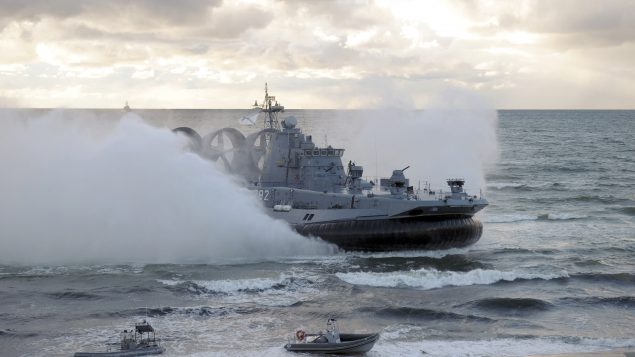






For reasons beyond our control, and for an undetermined period of time, our comment section is now closed. However, our social networks remain open to your contributions.